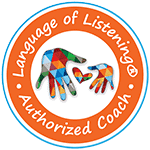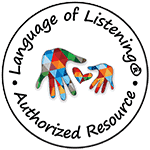Inside: If you’re a parent with a toddler not listening, you’ll LOVE these simple communication strategies that can change everything. Help your child listen better, get the cooperation you want and start enjoying parenting again.
My kids and I were browsing through the toy section for a birthday gift last week, when I heard a little girl screaming in the background. Her screams started to get louder, and when I turned my head to look, there she was trailing three feet behind her dad, sobbing.
He continued walking, clearly trying to keep his cool. “You’re not getting the toy. End. Of. Story. Toys are for special occasions only.”
She cocked her head back, opened her mouth and wailed. “But that’s my fave-wut murhmaid.”
I could tell the dad was reaching his limit, and in truth, so was she. He took a deep breath and tried to again reason with her. “I already told you, you’re not getting the toy. It’s too expensive.”
These are the moments you wish were saved for the privacy of your own home. (Or at least the car.) I used arrive at a store and hope for-the-love-of-chocolate that my kids would not throw a full-blown tantrum in public. Because you want the world to see your best, not the moment when you’re left to wonder why, no matter how hard you try, your toddler won’t listen the first time.
Related: 2 Year-Old Not Listening? Try This Remarkable Tip
The little girl collapsed onto the floor of the store. Pouring her head into her hands, she continued to sob a few feet away from where we stood.
After two years of Language of Listening® training, I have a hard time not intervening in these types of situations because I know simple shifts can change everything for both the parent and child.
I decided to try something.
I walked a few steps over to the dad where he was standing over his daughter. “I think I can help.” He kinda just looked at me. It wasn’t a resounding yes for help, but he didn’t say no either.
I took it as an opportunity to try something really quick.
Maybe it would work. Maybe it wouldn’t.
I knelt down to the little girl and lowered my face to the floor. “You really want that mermaid! It’s your favorite thing in the whole world!”
Girl (crying): “Yeah. I weally want it.”
“Hmmm…you really want the mermaid and sounds like that won’t work for your dad. Must be some way you could get your mermaid.”
Girl (stops crying): “Yeah.”
“Show me the mermaid.”
She took me one isle over, and I could tell the dad is wanting this to be over. I was wondering what I got myself into. Who wants another parenting intervening in the store!
The girl and I were about 30 seconds into our time together, and I knew I didn’t have much more before the dad was going to pick up and leave.
She pointed to the mermaid.
“Oh I SEE. She’s got a super shiny purple fin and purple hair too. Of course, you wish you could play with her right now!”
She nodded and I knew I was on track.
“Hmmm…maybe you could ask your dad if you could put that mermaid on your birthday or Christmas list. You could even wish for 1,000 mermaids as gifts!”
Girl: “Yeah!!!”
In about two minutes, the girl was calm, the dad kept his boundary of not letting her get the mermaid, and everyone won.
Why this works for a toddler not listening.
Toddler behavior does not always make a whole lot of sense. This is especially true if you’re an adult because your brain acts out of logic and reasoning. Toddler brains act out of emotion and zero–absolutely zero–logic.
When kids see something they love in the moment, they fall madly in love. Completely head-over-heels-in-love with a mermaid they didn’t even know existed two minutes before. Knowing this, it makes so much sense why a child would go from zero to sixty on an emotional scale of zero to ten.
And THEN, when kids hear something along the lines of “not now,” they think “never.” So when you’re out running errands, and the child asks for something and you say “no,” they think that means never ever, ever could they have a mermaid for the rest of their lives.
The same is true of buying something “one time” and your child thinking that means “always.” You can buy a toy at the store one time, and each time you return, your child will sob and say, “But you always buy me a toy!”
Related: 3 Year-Old Not Listening? Try This Tip for High Energy Kids
Kids really do think like this.
If you start with logical reasoning, a very young child will not understand this, and it can backfire. When kids are trapped inside their very young emotional brains, logical reasoning is nothing more than white noise.
If you’re able to validate what the child wants in the moment, and open her up to the idea that it’s possible to wish for what she wants. She may or may not get it for her birthday or Christmas (and by then she may not care anyway), but she needs to know that it’s possible.
If putting it on a Christmas or birthday list doesn’t work for you, you can also grant your child’s wish in fantasy. The more detail you add to make if feel real, the quicker this will meet the child’s need.
Related: How to Use Wants and Wishes With a Complaining Child to Gain Cooperation
You’re not changing your boundary, only your explanation of it. Once you’re child is calm, you can dive into guidance and teaching and your message will be heard so much quicker.
From there, your two worlds can meet in the middle of logic, boundaries, emotion and the love of mermaids with shiny purple fins.
More communication tips for toddlers and preschoolers.
Over the past several years, I’ve learned some phrases that are so useful to try with a toddler not listening. When you understand the way kids think, it can make sense why these approaches work.
“Show me”
From a developmental standpoint, toddlers and preschoolers understand far more than they can perfectly articulate. This is especially true when they are running on emotional highs like excitement, anger, frustration, etc. If you try “tell me what’s wrong” or “use your words” and that’s not working for you, you can try “show me” and see if they child is able to point or demonstrate what’s upsetting them.
“Of course, you want to…”
More than anything, kids want to know that what they want matters to somebody. Taking the time to validate what a child wants can be enough to help them calm down. This is because all kids will continue to communicate until they feel heard. They can’t stop until they believe you understand them. Once they know you hear and understand, they can stop trying to tell you (which is often communicated through screaming and tantrums) what’s bothering them.
Related: How to Handle Back Talk Like a Parenting Warrior
“Looks like you need a hug.”
Connection is a basic human need that we all crave. We all want to feel a sense of belonging and acceptance. When kids are losing control of their emotions, they are secretly asking for your help, even as they push you away. A simple hug, touch on the shoulder or rub on the back can let the child know that you are there. If a child pushes you away or won’t let you hug them, you can say, “I’m here if you need a hug.”
“Let’s play a game.”
To kids, everything is a game. If you can take a boundary pushing situation and turn it into a playful parenting game, it can shift the power struggle into cooperation. I always love to use the example of teeth brushing. Kids love to fight teeth brushing because it often means bedtime is near, and they are looking for more ways to connect with you.
Once we were able to turn teeth brushing into a game where I find my kids favorite cartoon characters inside their mouths, brush them away and allow the kids to spit them out into the sink, everything changed. We haven’t had a teeth-brushing battle since, and that was after several years of power struggles. Finding a game your child loves can change everything.
“Hit this pillow and pretend it’s me.”
I often hear from worried parents at their wits end over hitting, kicking and biting with toddlers and preschoolers. At younger ages, kids will use hitting, kicking and biting as a way to meet their need for power. It’s totally natural. In order to meet a younger child’s need for power quickly, give them something soft to hit, kick or bite.
This is only temporary so you can meet the child’s need for power, and from there, he or she will open up to your guidance, and you can work on teaching self-control. As brain development unfolds, your child will gain more and more self-control and other strategies like ripping paper, screaming or calmly telling you how they feel will work. Until then, you can use this simple strategy to help you get through the moment.
Want more on parenting?
- Two words That Will Tame a Temper Tantrum – Every Time
- How to Get Better Listening and More Cooperation Using a Visual Routine for Kids
- One Surefire Way to Stop Entitlement and Raise Kind Kids
- To the Mom of a Spirited Toddler, You Are Stronger Than You Think
- Parenting Anger: How to Help Yourself Cope When You’re Triggered
I've created a free email series just for you! If you are struggling with teaching your child to listen, this series will help transform your parenting. Yes, really. I've seen my proven strategies work time and time again for parents. I know it can work for you too.
After taking my free email series, you will:
- Learn simple, yet highly effective listening strategies
- Experience a stronger connection with your child
- Enjoy more peaceful parenting days
- Gain more cooperation from your child

















I definitely will keep the pillow trick in mind when my son wants to hit something.
I started using your suggestion of offering them a hug and its worked wonders!
That’s awesome to hear! Thanks for sharing your experience.
-Lauren
Lauren, you did it! You bravely stepped up for that little family and helped the dad and the child in the store! I’ll bet he didn’t know what to think, but what a gentleman to let you try. Wonderful example of how simple tantrum de-escalation can be.
I can’t stop laughing. He was a gentleman to let me try! Sometimes I look back on these moments and wonder if I was too bold, but I hope he saw it as helpful that they could both leave the store in peace.
Hi Lauren!
Your e-book and emails are so helpful and geately appreciated! I have so far had success with a similar tactic since my 2yr old was able to “I want” even before the ability to verbalize it, I have been able to keep her happy simply by allowing her to give the toy a hug and putting it back with “it’s family and friends”. I’ve had to let her hold on to something a bit longer a few times but she usually loses interest shortly after that. I doubt this will work for me all that much longer but now I’m ready with these other tactics thanks to you!
Thanks a bunch,
Aimee
I’m so glad you found this helpful, Aimee! Having wants and wishes validated by someone else is a very BIG deal to a child, but also to adults as well. Think about how good if feels to know that others “get it” and understand you. That simple step of validating your daughter will help you stay connected well beyond the toddler years. Thank you for reading! Talk soon, Lauren
After reading your email’s about listening, it worked within minutes with my toddler! My husband and I stated at each other the second my son said, “yes I want it for my birthday then.” Then off he went:)
Thank you so much for sharing this! I’ve already sent your link to literally all of my friends, siblings. . Even my parents “because I said so” is what I grew up with my parents.. come on 90 kids ? it’s life changing! My husband and I don’t feel like “failures”
OH wow! That is so awesome Nikki. I’m glad this was helpful for you!
This was a beautiful insight! As a mom of a very passionate and stubborn three-year-old, I needed to read this! I’m looking forward to listening and reacting better. I signed up for your list to learn more. Thank you!
I’m so glad this spoke to you, Rachel!
Hi! Looking for some advice with my 23 month old boy. He is quite the rambunctious little guy. He likes to grab/kicking and yelling ” go” at the dogs. I say ” I don’t want you to hurt the dogs” or ” I won’t let you hurt the dogs” and then block his motion and hold his hands if need be. He continues to do it and he has a smile on his face! Doesn’t seem to care at all. Meanwhile my poor dogs are so upset. Thank you in advance for any advice!